In Situ Observation of the Deformation and Fracture Behaviors of Long-Term Thermally Aged Cast Duplex Stainless Steels
Abstract
1. Introduction
2. Materials and Methods
3. Results and Discussions
3.1. Microstructure Observation
3.2. Thermal-Aging-Induced Mechanical Property Changes
3.3. In Situ SEM Observation of Crack Initiation in the Aged CDSS
3.4. TEM Observation of Deformed Microstructures in the Aged CDSS
3.5. Fracture Mechanism of the Thermally Aged CDSS
4. Conclusions
Author Contributions
Funding
Conflicts of Interest
References
- Chung, H.M. Aging and life prediction of cast duplex stainless steel components. Int. J. Pres. Vessels Pip. 1992, 50, 179–213. [Google Scholar] [CrossRef]
- Pareige, C.; Novy, S.; Saillet, S.; Pareige, P. Study of phase transformation and mechanical properties evolution of duplex stainless steels after long term thermal ageing (>20 years). J. Nucl. Mater. 2011, 411, 90–96. [Google Scholar] [CrossRef]
- Li, S.L.; Wang, Y.L.; Zhang, H.L.; Li, S.X.; Zheng, K.; Xue, F.; Wang, X.T. Microstructure evolution and impact fracture behaviors of Z3CN20-09M stainless steels after long-term thermal aging. J. Nucl. Mater. 2013, 433, 41–49. [Google Scholar] [CrossRef]
- Kawaguchi, S.; Sakamoto, N.; Takano, G.; Matsuda, F.; Kikuchi, Y.; Mráz, L. Microstructural changes and fracture behavior of CF8M duplex stainless steels after long-term aging. Nucl. Eng. Des. 1997, 174, 273–285. [Google Scholar] [CrossRef]
- Chen, Y.; Alexandreanu, B.; Chen, W.Y.; Natesan, K.; Li, Z.; Yang, Y.; Rao, A.S. Cracking behavior of thermally aged and irradiated CF-8 cast austenitic stainless steel. J. Nucl. Mater. 2015, 466, 560–568. [Google Scholar] [CrossRef]
- Chandra, K.; Singhal, R.; Kain, V.; Raja, V.S. Low temperature embrittlement of duplex stainless steel: Correlation between mechanical and electrochemical behavior. Mater. Sci. Eng. A 2010, 527, 3904–3912. [Google Scholar] [CrossRef]
- Yamada, T.; Okano, S.; Kuwano, H. Mechanical property and microstructural change by thermal aging of SCS14A cast duplex stainless steel. J. Nucl. Mater. 2006, 350, 47–55. [Google Scholar] [CrossRef]
- Shiao, J.J.; Tsai, C.H.; Kai, J.J.; Huang, J.H. Aging embrittlement and lattice image analysis in a Fe-Cr-Ni duplex stainless steel aged at 400 °C. J. Nucl. Mater. 1994, 217, 269–278. [Google Scholar] [CrossRef]
- Timofeev, B.T.; Nikolaev, Y.K. About the prediction and assessment of thermal embrittlement of Cr–Ni austenitic–ferritic weld metal and castings at the ageing temperatures 260–425 °C. Int. J. Pres. Vessels Pip. 1999, 76, 849–856. [Google Scholar] [CrossRef]
- Miller, M.K.; Russell, K.F. Comparison of the rate of decomposition in Fe-45% Cr, Fe-45% Cr-5% Ni and duplex stainless steels. Appl. Surf. Sci. 1996, 94, 398–402. [Google Scholar] [CrossRef]
- Chung, H.M.; Leax, T.R. Embrittlement of laboratory and reactor aged CF3, CF8, and CF8M duplex stainless steels. Mater. Sci. Tech. Lond. 1990, 6, 249–262. [Google Scholar] [CrossRef]
- Lo, K.H.; Shek, C.H.; Lai, J.K.L. Recent developments in stainless steels. Mater. Sci. Eng. R 2009, 65, 39–104. [Google Scholar] [CrossRef]
- Chandra, K.; Kain, V.; Bhutani, V.; Raja, V.S.; Tewari, R.; Dey, G.K.; Chakravartty, J.K. Low temperature thermal aging of austenitic stainless steel welds: Kinetics and effects on mechanical properties. Mater. Sci. Eng. A 2012, 534, 163–175. [Google Scholar] [CrossRef]
- Takeuchi, T.; Kameda, J.; Nagai, Y.; Toyama, T.; Matsukawa, Y.; Nishiyama, Y.; Onizawa, K. Microstructural changes of a thermally aged stainless steel submerged arc weld overlay cladding of nuclear reactor pressure vessels. J. Nucl. Mater. 2012, 425, 60–64. [Google Scholar] [CrossRef]
- Li, S.L.; Zhang, H.L.; Wang, Y.L.; Li, S.X.; Zheng, K.; Xue, F.; Wang, X.T. Annealing induced recovery of long-term thermal aging embrittlement in a duplex stainless steel. Mater. Sci. Eng. A 2013, 564, 85–91. [Google Scholar] [CrossRef]
- Danoix, F.; Auger, P. Atom probe studies of the Fe-Cr system and stainless steels aged at intermediate temperature: A review. Mater. Charact. 2000, 44, 177–201. [Google Scholar] [CrossRef]
- Danoix, F.; Auger, P.; Blavette, D. Hardening of aged duplex stainless steels by spinodal decomposition. Microsc. Microanal. 2004, 10, 349–354. [Google Scholar] [CrossRef]
- Zhang, B.; Xue, F.; Li, S.L.; Wang, X.T.; Liang, N.N.; Zhao, Y.H.; Sha, G. Non-uniform phase separation in ferrite of a duplex stainless steel. Acta Mater. 2017, 140, 388–397. [Google Scholar] [CrossRef]
- Jia, N.; Peng, R.L.; Brown, D.W.; Clausen, B.; Wang, Y.D. Tensile deformation behavior of duplex stainless steel studied by In-Situ Time-of-Flight neutron diffraction. Metall. Mater. Trans. A 2008, 39, 3134–3140. [Google Scholar] [CrossRef]
- Hazarabedian, A.; Marini, B. Quantification of damage progression in a thermally aged duplex stainless steel. Mater. Res. 2002, 5, 113–117. [Google Scholar] [CrossRef]
- Hazarabedian, A.; Forget, P.; Marini, B. Local approach to fracture of an aged duplex stainless steel. Mater. Res. 2002, 5, 131–135. [Google Scholar] [CrossRef]
- Li, S.; Wang, Y.; Li, S.; Zhang, H.; Xue, F.; Wang, X. Microstructures and mechanical properties of cast austenite stainless steels after long-term thermal aging at low temperature. Mater. Des. 2013, 50, 886–892. [Google Scholar] [CrossRef]
- Li, S.; Wang, Y.; Wang, X.; Xue, F. G-phase precipitation in duplex stainless steels after long-term thermal aging: A high-resolution transmission electron microscopy study. J. Nucl. Mater. 2014, 452, 382–388. [Google Scholar] [CrossRef]
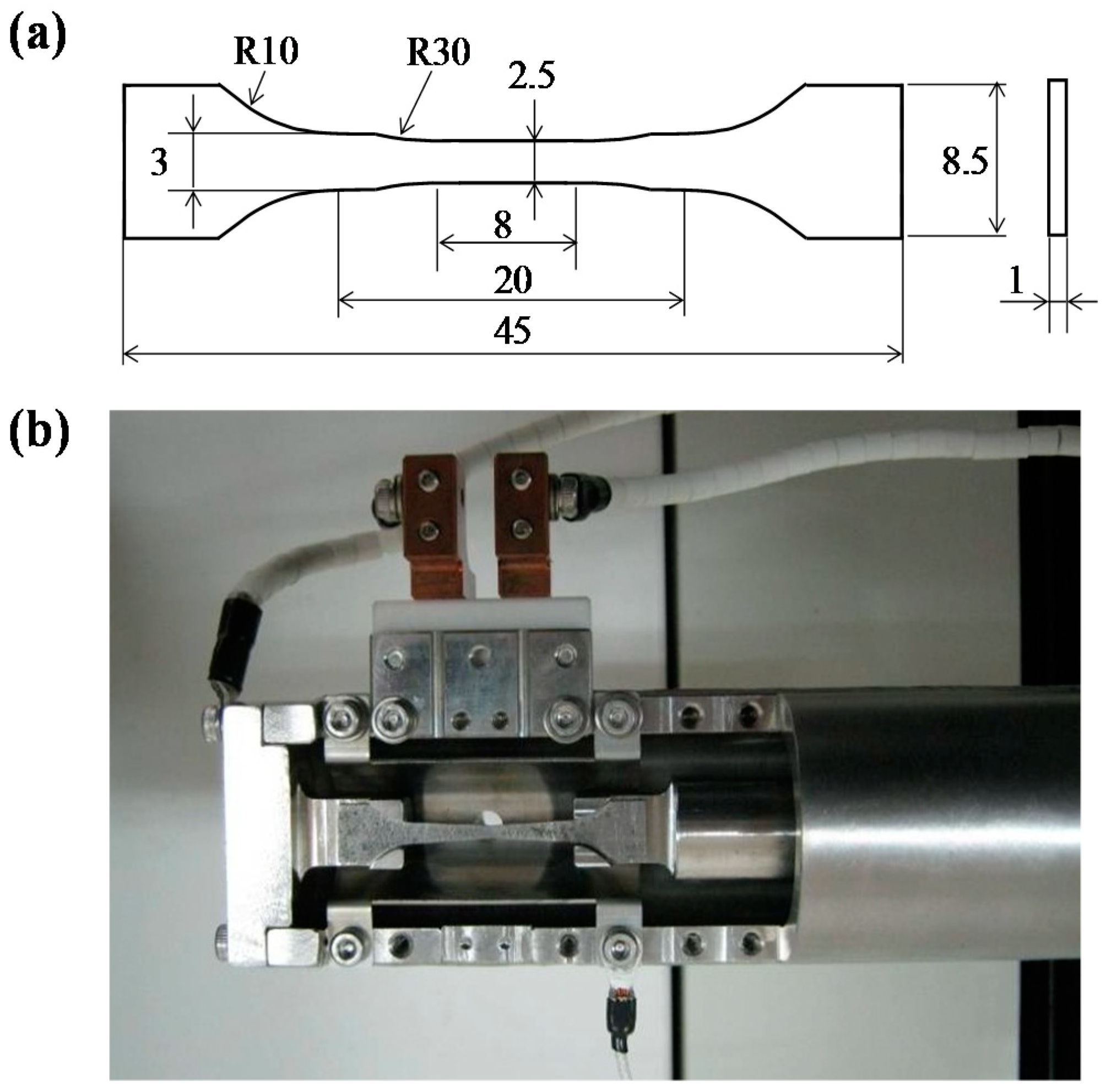
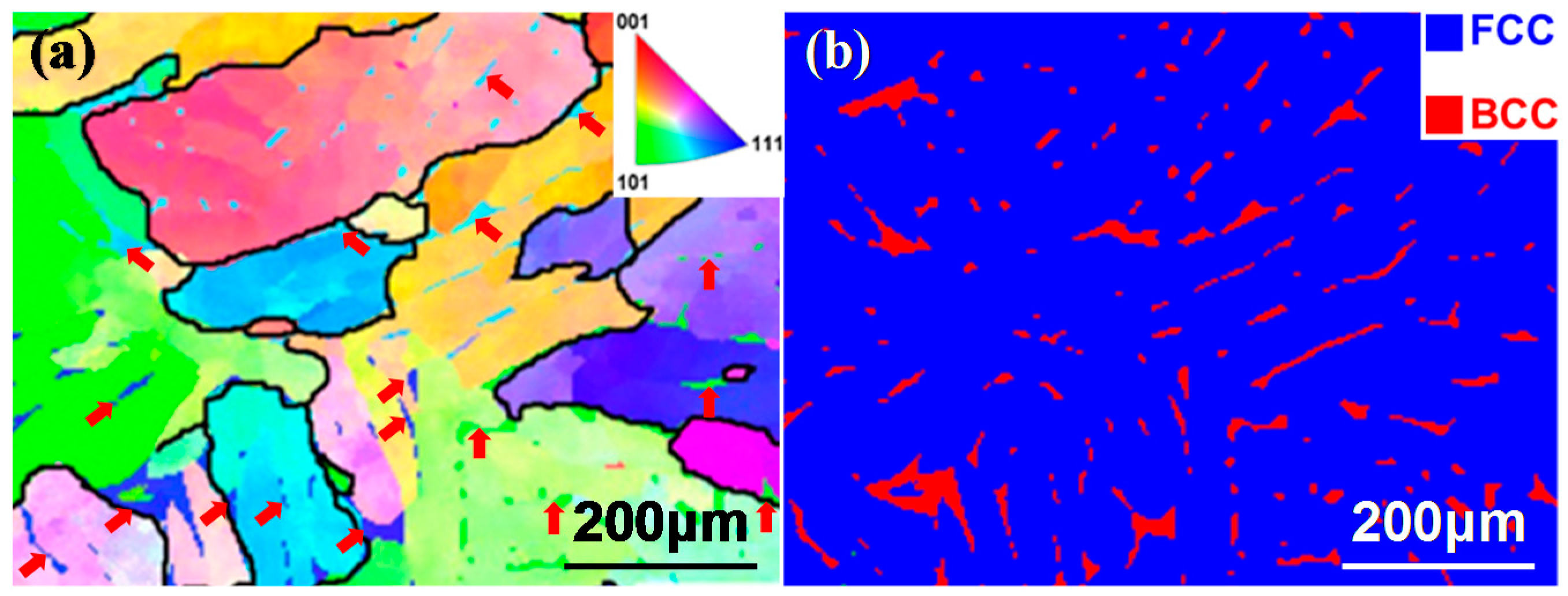
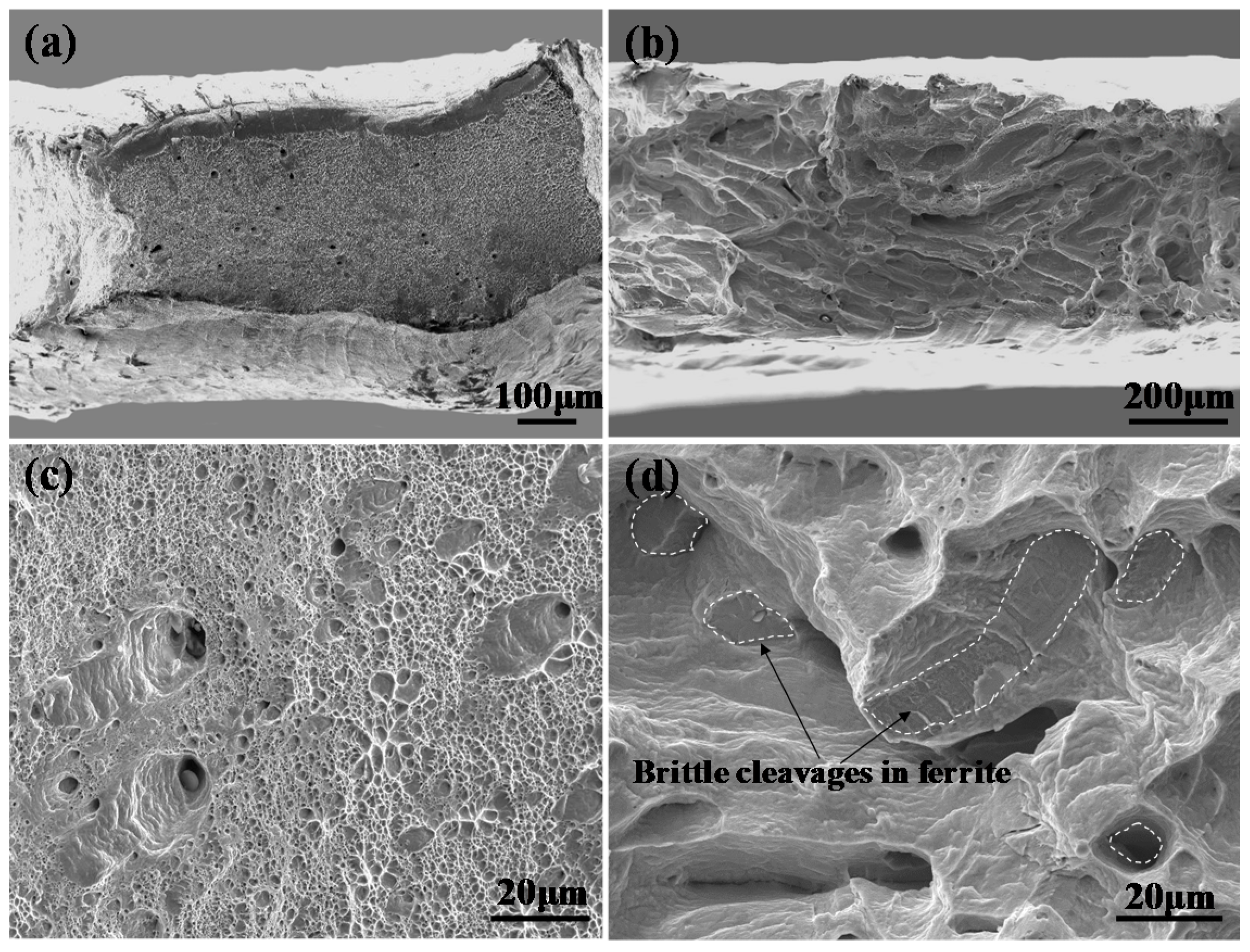
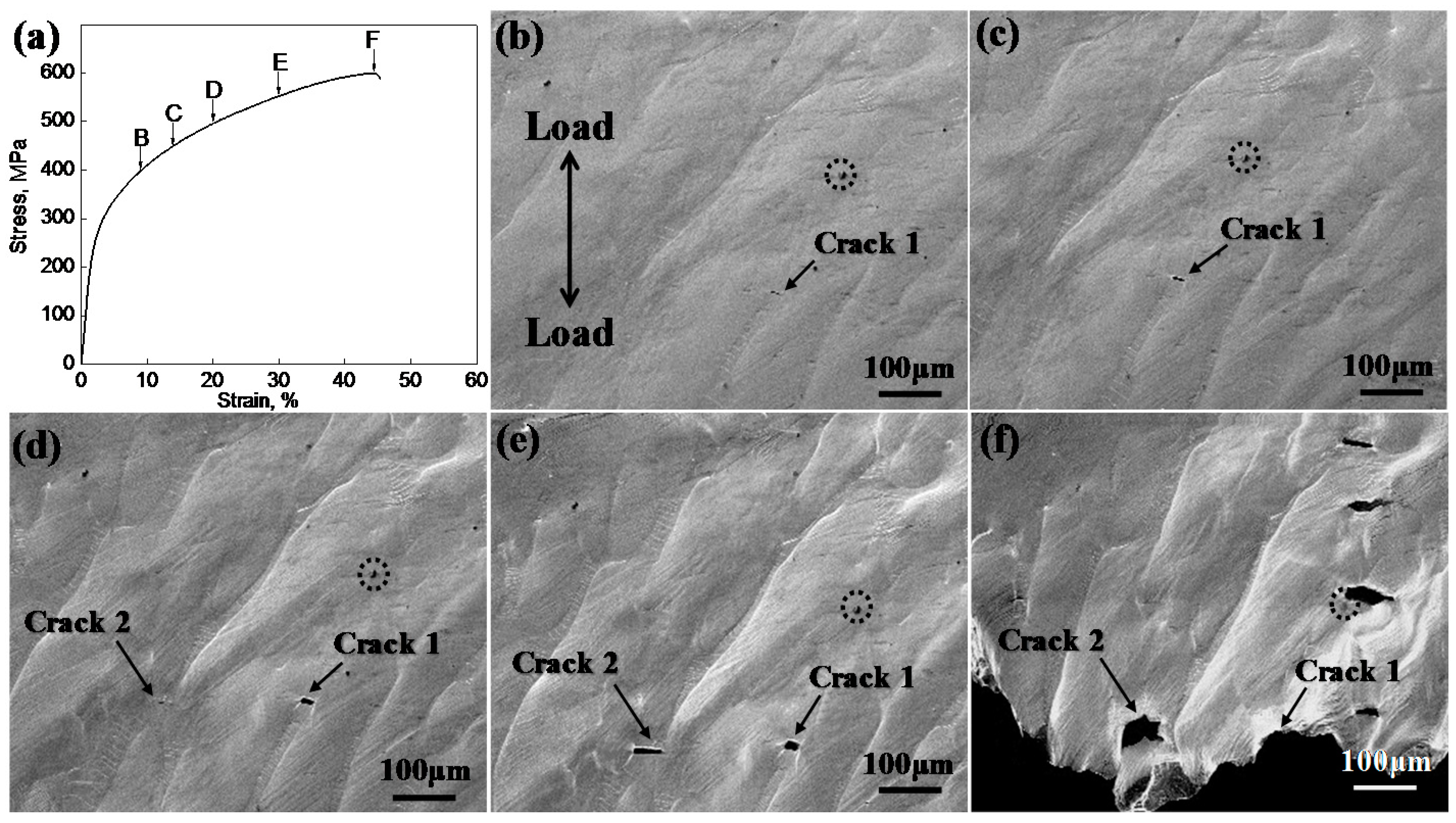
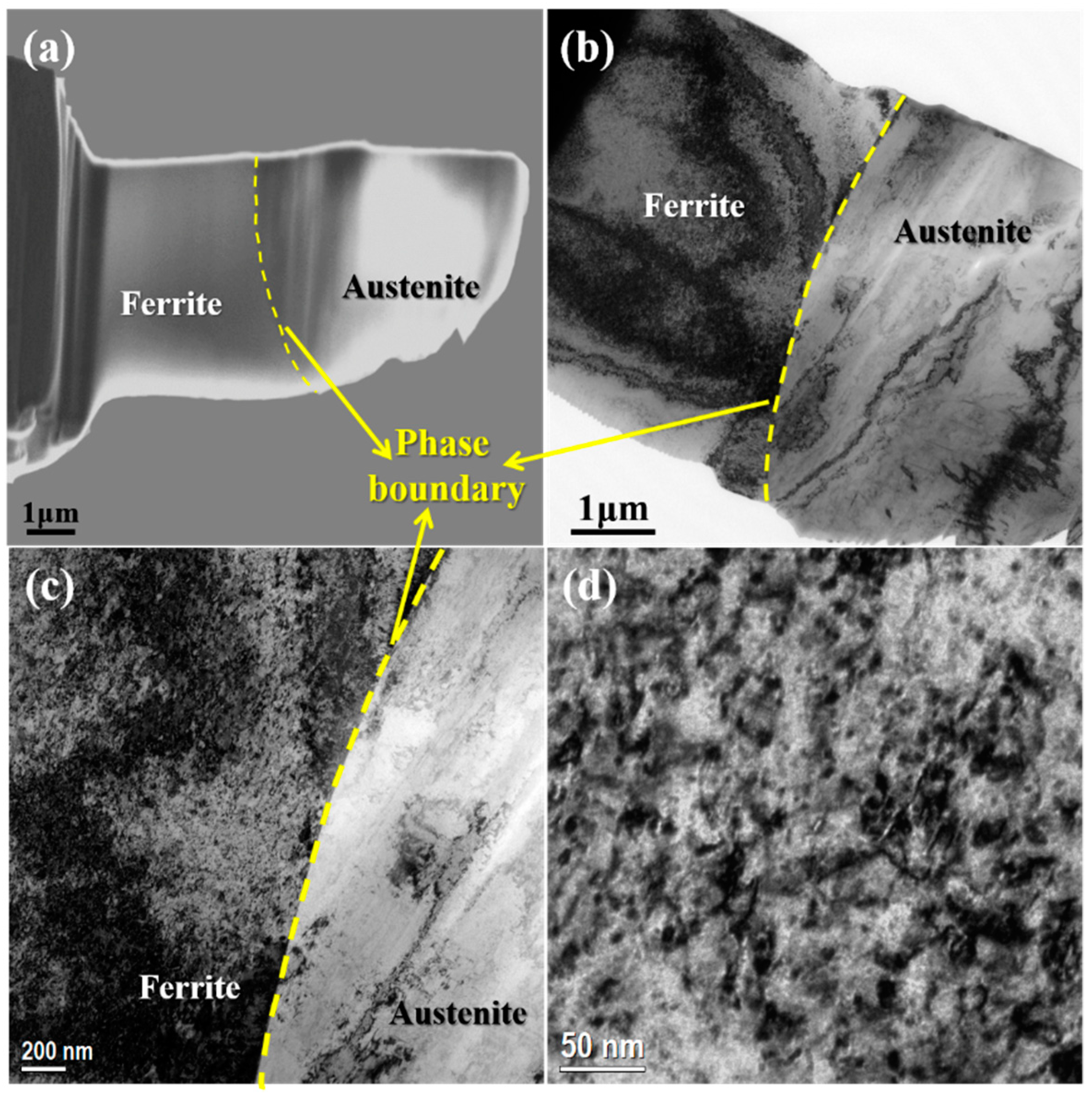
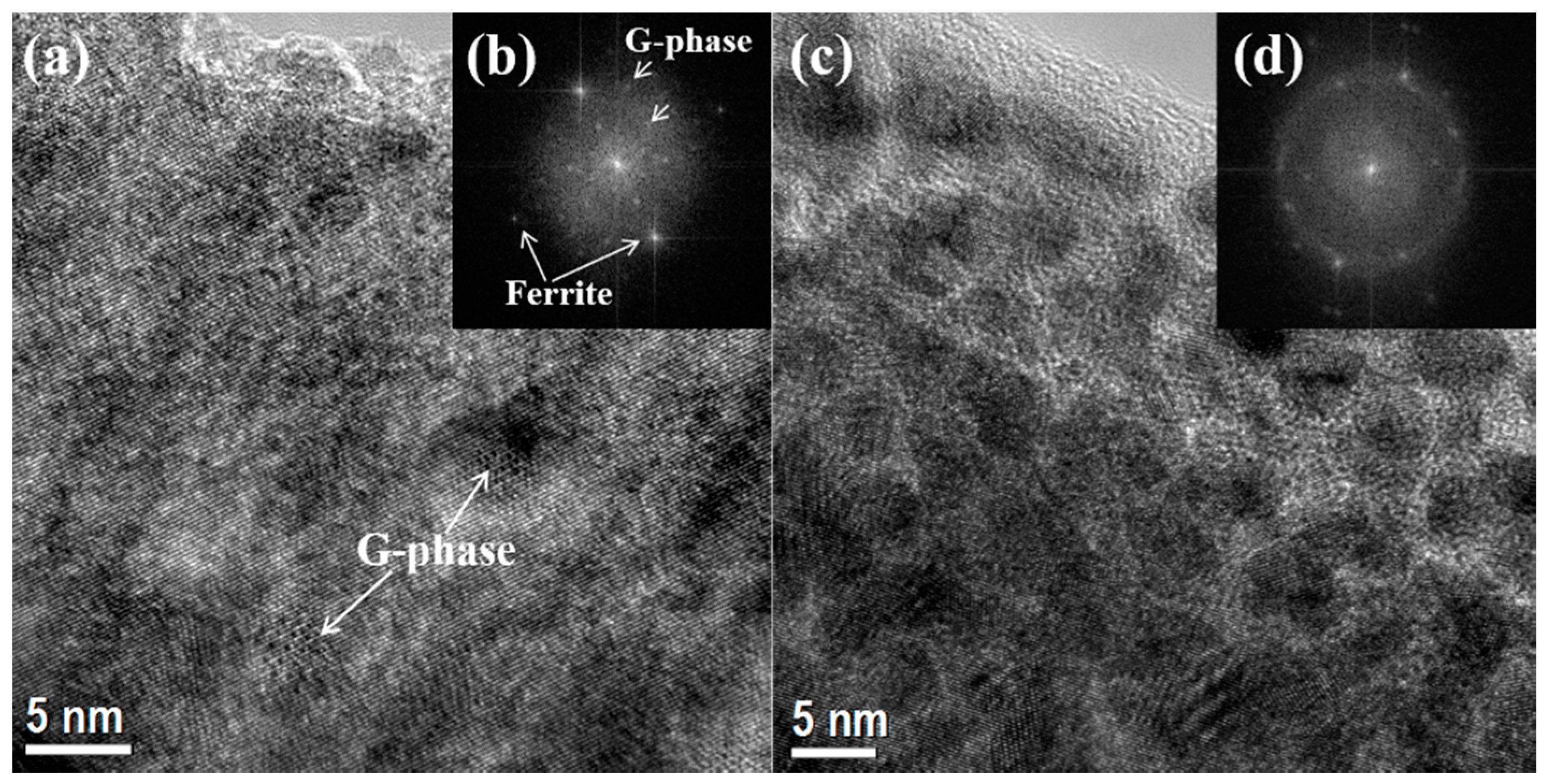
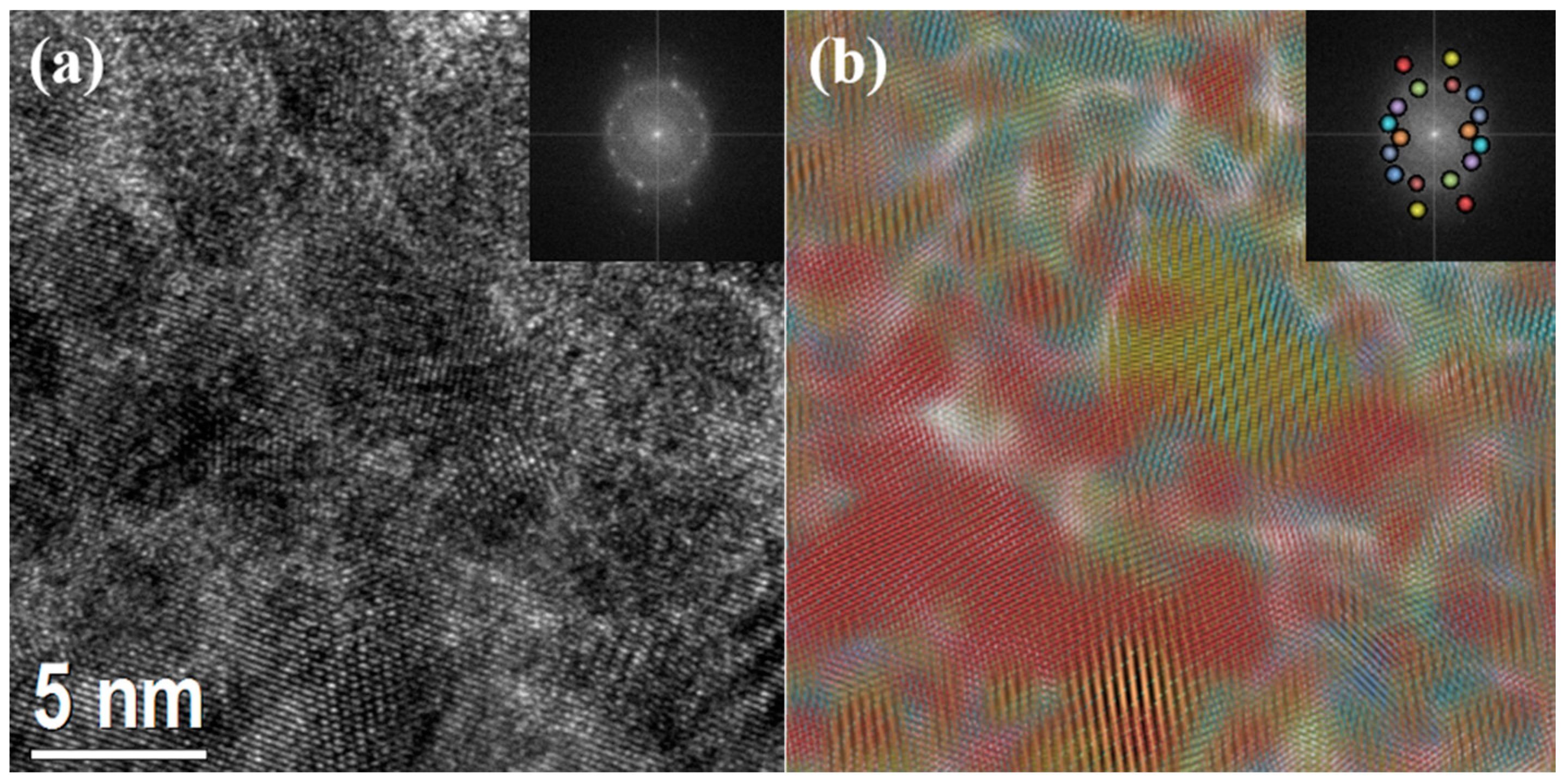
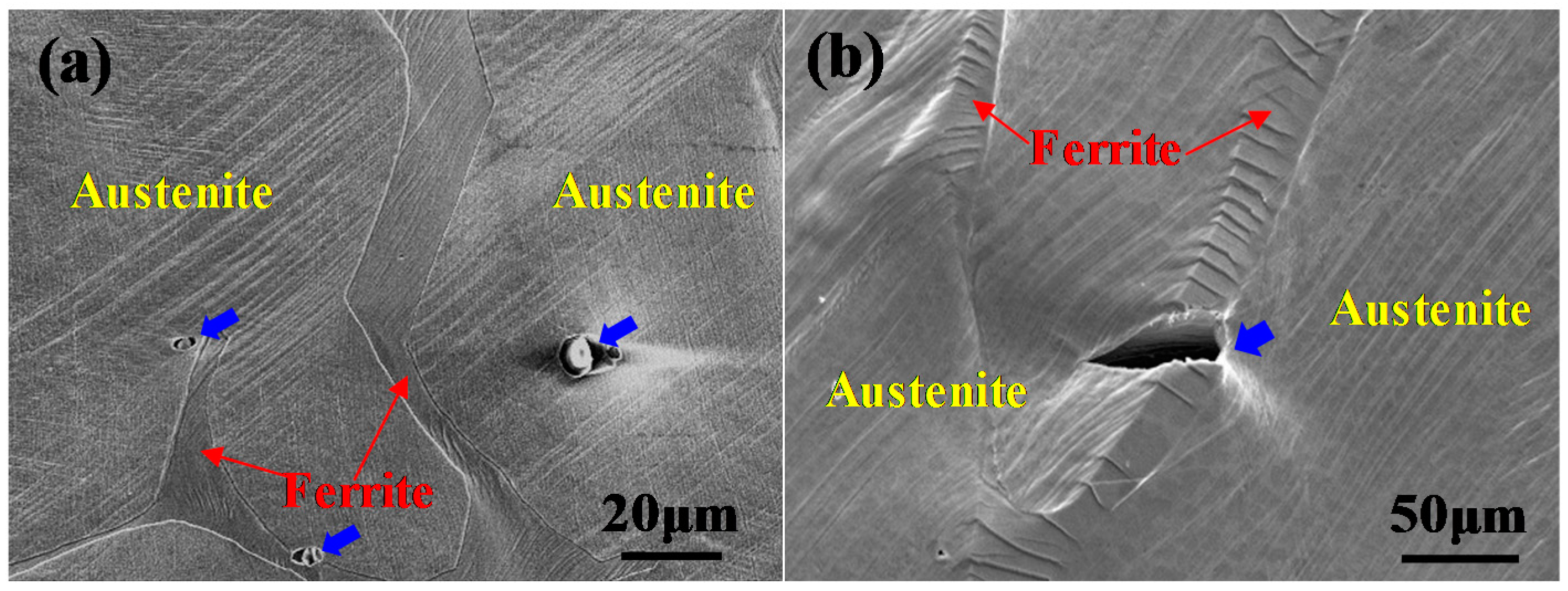
| Materials | Tensile Properties | Vickers Hardness, HV | |||
|---|---|---|---|---|---|
| Yield Strength YS (MPa) | Ultimate Tensile Strength UTS (MPa) | Elongation (%) | Austenite | Ferrite | |
| Un-aged | 237.4 | 523.5 | 54.6 | 217.1 ± 17.2 | 230.1 ± 8.9 |
| Aged for 3000 h | 288.3 | 674.9 | 40.1 | 211.6 ± 13.5 | 468.7 ± 20.9 |
| Aged for 20,000 h | 230.7 | 599.8 | 44.1 | 201.3 ± 10.8 | 556.4 ± 71.9 |
© 2019 by the authors. Licensee MDPI, Basel, Switzerland. This article is an open access article distributed under the terms and conditions of the Creative Commons Attribution (CC BY) license (http://creativecommons.org/licenses/by/4.0/).
Share and Cite
Li, S.; Wang, Y.; Wang, X. In Situ Observation of the Deformation and Fracture Behaviors of Long-Term Thermally Aged Cast Duplex Stainless Steels. Metals 2019, 9, 258. https://doi.org/10.3390/met9020258
Li S, Wang Y, Wang X. In Situ Observation of the Deformation and Fracture Behaviors of Long-Term Thermally Aged Cast Duplex Stainless Steels. Metals. 2019; 9(2):258. https://doi.org/10.3390/met9020258
Chicago/Turabian StyleLi, Shilei, Yanli Wang, and Xitao Wang. 2019. "In Situ Observation of the Deformation and Fracture Behaviors of Long-Term Thermally Aged Cast Duplex Stainless Steels" Metals 9, no. 2: 258. https://doi.org/10.3390/met9020258
APA StyleLi, S., Wang, Y., & Wang, X. (2019). In Situ Observation of the Deformation and Fracture Behaviors of Long-Term Thermally Aged Cast Duplex Stainless Steels. Metals, 9(2), 258. https://doi.org/10.3390/met9020258






